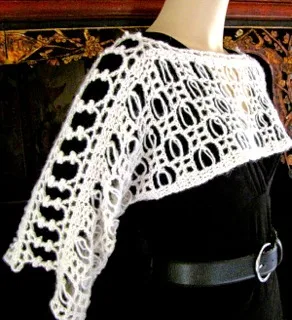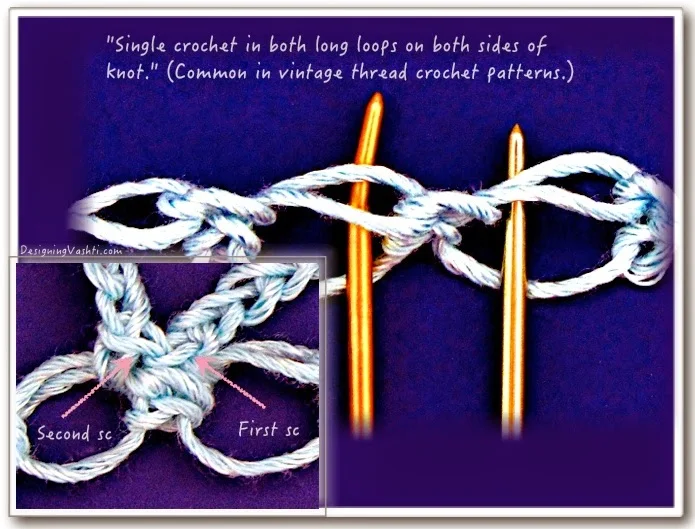Today is about how to crochet your next row into Love Knots. Topics of the other two posts are:
- How to Crochet a Love Knot. Or see this freshly updated version.
- Crocheting Into Love Knots: Special Tweaks.
 |
| Top to Bottom: Dragonfly Cord, Seagrape Anklet, Sambuca Necklace. |
Yesterday's post was about crocheting a single string of Love Knots. Depending on your project, it might be called "the foundation row" or "Row One" or, "Hey look, I just made a necklace/eyeglass cord/wrap bracelet/ tie belt!"
 |
| Free Love Knot pattern: Buffalo Knot Belt |
Things get really interesting when we crochet Love Knots (and other stitches) into Love Knots. Not only do we have fun choices, Love Knots can mess with your mind. Seriously.
A single string of Love Knots is three-dimensional, like a sculpture of bubbles. Crocheters often lose their way when it's time to turn and begin a new row. The risk of accidents (changing the stitch count, adding a twist in the foundation row) can make even a seasoned crocheter twitchy about this stitch.
The first step is to know when your Love Knot is upside down! Let's dissect the loopiness.
Anatomy of a Love Knot
 |
 |
| Doesn't the bottom of the single crochet look weird when it's facing up? |
The top two loops of the single crochet (sc) have more of the familiar chain-link look, like the top two loops almost all crochet stitches have (tinted pink, above).
Unless a crochet pattern states otherwise, plan to crochet your next row into both top loops of either the sc (pink) or the long loops (green).
The Three Ways to Crochet Into Love Knots
Method 1.
The most common nowadays is to single crochet (sc) into the sc "knot" part. (I say "nowadays" because old thread crochet patterns often used the second method, below.) |
| Insert your hook under the pink loop AND the other top loop behind it (not showing in this photo.) |
 |
| An example of sc stitches crocheted into the sc of Love Knots (Sister Act Shawl). |
This is the method I used for the "Sister Act Shawl and Shrug" published in Interweave Crochet magazine, Summer 2013 issue.
 |
| Fish Lips Lace. |
Less common variations: You can crochet a different stitch into the Love Knot sc, for example double crochets (dc; UK: tr). That's what I did for the Fish Lips Shrug.
When you crochet taller stitches into the Love Knot sc's, special things happens. The Love Knots have more room to expand. I find that Love Knots have a special affinity for dc stitches in terms of scale.
Method 2.
Single crochet before and after the sc "knot." This means one sc into two long top strands of one Love Knot just before the next sc "knot," and a second sc into two long top strands of the next Love Knot just after the sc "knot."This traditional method has several merits. It makes even the finest thread easy to crochet with, because the long loops are very easy to see and crochet into with a tiny, tiny crochet hook. It reinforces the places where the rows are linked to each other. The weight-bearing stress is distributed across more threads and stitches. This helps even the largest, most delicate lace pattern support its own weight, with less wear - while also holding open the lacy part of each Love Knot!
 |
| Method 2: Emphasis on the knots. |
It does take a bit of foresight when planning the foundation row because you'll be adding more stitches in the next row (another sc each time you crochet into the Love Knots). Another factor to consider is that the extra sc can make the knot parts look lumpier in thicker yarns.
Variations: I hope you feel free to try this with other stitches besides a sc, such as the half double (hdc; UK: htr). Crocheters did 100 years ago!
Method 3.
This is the rarest of the three: crochet into the long strands of only one Love Knot (not two, like in Method 2). In the inset photo below you can see a resulting stitch pattern. In the top two long loop of each Love Knot I crocheted a sc and a Love Knot.This Marisa Artwalk (in progress) is a free form type of Love Knot pattern. Part of its unusual look is due to using Method 3.
 |
| Marisa Artwalk |
Did you enjoy this post? I want to hear about it and so do your friends! Please check back for the third installment.
Part 1 of 3: How to Crochet a Love Knot.
Part 3 of 3: Crocheting Into Love Knots: Special Tweaks.
UPDATE: I posted a fresh revision of Part 1, and from there you should see Crocheting the Love Knot Mesh.


Thanks so much for all the great Info & Tips!
ReplyDelete